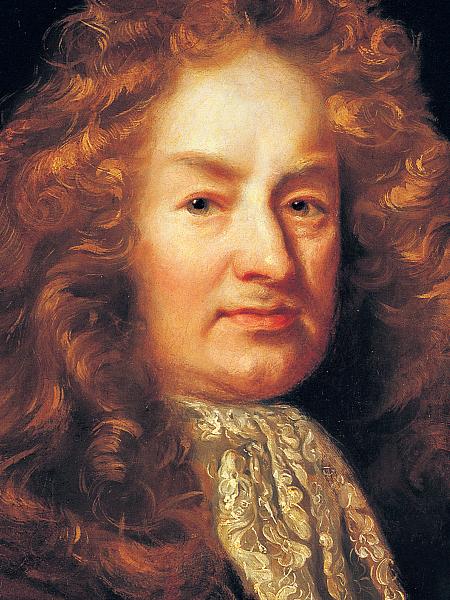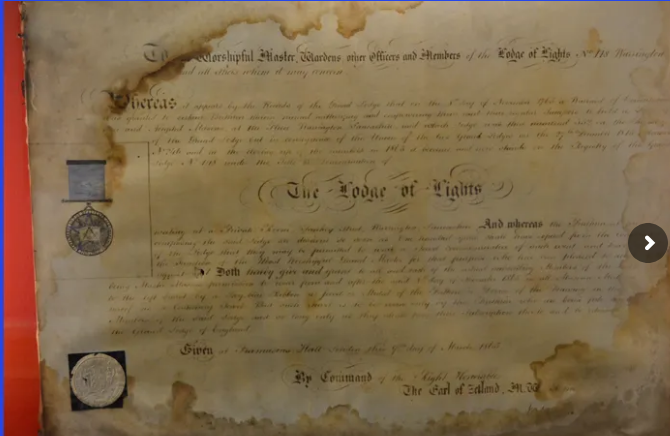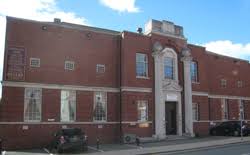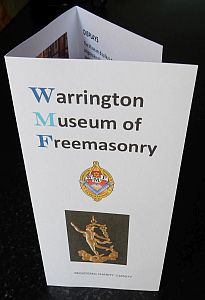20191114 CLHG report Masons. DRAFT
20191114 CLHG report Masons.
“Warrington Freemasons in Culcheth”.
On Thursday 14th November 2019, our members had the pleasure of an interesting talk illustrated by slides presented by a team of four Freemasons in Warrington, lead by Mr Victor Charlesworth, Curator of the Warrington Museum of Freemasonry and ably assisted by Caroline Crook, the Archivist of the Warrington Museum of Freemasonry.
Link:
http://museum.westlancsfreemasons.org.uk
The speaker started by saying what “Freemasonry was not”; as there are many rumours and tales from folk who do not know it origins or purposes in general circulation. Then followed by “What Freemasonry actually is”.
This is best summarized by words from the museum’s own booklet.
What Freemasonry is.
“Freemasonry is a secular, fraternal organisation.
It teaches its members moral lessons and self-knowledge through participation in a progression of allegorical two-part plays. These are learnt by heart and performed within each Lodge, following ancient forms and symbolically using stonemasons’ customs and tools.”
A description of how the rituals were based on ‘methods’ to prove a person was not a ‘branded criminal’ (by the tale of exposing the breast to show there were no brand marks on the body), and that they were fit to do duty by displaying they had no injured limb (raising trousers) gave a historical idea of how some rituals developed in their group.
LODGE.
The word used for the group and its meeting place is assumed to come from the temporary wooden structures ‘lodges’ use by itinerant masons encamped at a building site such as a cathedral, while working there. Compare them to the “Container Cabins” used by people on building sites in today’s construction industry. Although nowadays most workers sleep ‘off site’, the container office/rest room/meeting room is a vital part of today’s construction industry.
Starting of Freemasonry.
The actual start of Freemasonry is lost, but a person inducted to Freemasonry in Warrington in 1646 is the earliest extant written record.
THE FOUNDATIONS OF FREEMASONRY.
The questions of where, when, how and why Freemasonry originated are still the
subject of speculation.
The general consensus is that Freemasonry descends directly or indirectly from the organisation of working stone masons who built the great cathedrals and castles
of the medieval period. Freemasonry has a long and distinguished history. Many suppose it is much longer than its traceable 300 year plus history. While its origins are lost in the past there are a number of theories of how it began. However there are certainly strong links back to the mediaeval stone masons guilds.
Non-working Gentlemen admitted.
Their organisational unit, the lodge, began to admit men who were not working stonemasons beginning in England, with Sir Robert Moray who became a Freemason in Newcastle upon Tyne in 1642.
Warrington.
In 1646 in Warrington, Elias Ashmole became the first recorded Englishman initiated into an English Lodge.
It is assumed due to that recorded occasion that there had been Lodges throughout the British Isles before 1646 as one of the earliest recorded initiations in England was that of Elias Ashmole, founder of the Ashmolean Museum in Oxford, into a Lodge meeting at his father–law's house in Warrington Cheshire. In his diary in 1646 he recorded that “This day I was made Freemason”. Therefore, as a possible "speculative Freemason", Freemasonry must have been in operation before that date!
A “speculative Freemason” was a non-craftsman. While actual craftsman were designated ‘operative Freemason’.
Masonic records show his diary entry as:
The entries in Ashmole’s “Diary” which relate to his membership of the craft are three in number, the first in priority being the following:-
“1646, Oct. 16, 4.30. P.M. – I was made a Free
Mason at Warrington in Lancashire, with Coll: Henry Mainwaring of Karincham in
Cheshire. The names of those that were then of the Lodge [were] Mr Rich. Penket
Warden, Mr James Collier, Mr Rich. Sankey, Henry Littler, John Ellam Rich: Ellam
& Hugh Brewer.”
Link to Wikipedia page on Elias Ashmole.
https://en.wikipedia.org/wiki/Elias_Ashmole

Ashmole after Riley, Picture Note for Elias Ashmole after John Riley (d. 1691) - from English WikiPedia Public Domain.
Formation, split and reunion.
On 24 June 1717 four London lodges met at the Goose and Gridiron tavern in St Paul’s Churchyard, declared themselves a "Grand Lodge" and elected a Grand Master.
This was the first Grand Lodge in the world. It began to hold regular meetings and published the first rule book.
However, as is often usual in voluntary social societies, there were those who differ and a separate set of lodges arose using a different Grand Lodge. Then on 17 July 1751, representatives of a different set of five Lodges gathered at the Turk's Head Tavern, in Greek Street, Soho, London and formed a rival Grand Lodge called The Most Antient and Honourable Society of Free and Accepted Masons.
These two organisations operated with their different procedures and the split lasted for sixty two years until both came together in 1717 to the form the Grand Lodge of England since when the development of Freemasonry, and its spread worldwide, has been extremely well documented.
Working masons with skill transfer to apprentices and recognition of skill levels.
It is generally agreed that freemasonry developed from the medieval stonemasons. These were the operative masons who built the cathedrals and castles.
For security they met and lived in buildings or Lodges at their worksites.
To enable the Master in charge to ascertain the range of skills of the travelling stonemasons, (the ‘free masons’ - not tied as serfs or specifically serving a single master). [Think of the modern term for a qualified craftsman as a 'journeyman'.] The free masons who came to offer their services, acted as the stonemasons guilds, which like other crafts or guilds, developed basic ceremonies for passing their skills onto new apprentices. Therefore, like all Guilds, when the apprentice stonemason had achieved a certain skill level he was informed of certain recognition signs, tokens and passwords.
This was necessary as there were no trade union cards, nationally recognised examination bodies or certificates of apprenticeship. But, these recognition signs were used to regulate the craft. Communication of these signs, tokens and words enabled the Master Mason in charge of a project to know a man’s ability.
Communication of these signs, tokens and pass words were closely guarded and, to ensure that the young apprentice understood their importance to the craft, there were many blood curdling oaths placed on him should he divulge them. [It was a time when religious matters were every current in peoples lives.] These pass words have no place in today's society but the initiate is informed that these were once traditional to becoming a free mason.
“Gentlemen”.
No one knows why, but in the early 1600s, some operative Lodges began to admit non-craft-stonemasons. They were “accepted” or “gentlemen” masons. Gradually they took over and became Lodges of free and accepted or "speculative masons", no longer having any ‘practical’ connection with the stonemason’s craft of working stone.
As, at this time, only ‘learned’ people could read and write most documentation which has survived tended to be ‘official’ documents. Added to this was the fact that all ritual had to be committed to memory and none actually written down. Masonic Ritual was not published in book form until the late 1800’s, so it was no wonder that the first written documentation was in the diary of Elias Ashmole, in 1646. The Antiquary and Founder of the Ashmolean Museum in Oxford, who records in his diary that he was made a Free Mason at his father-in-law’s house in Warrington. None of those present, had any connection with operative craft masonry. Therefore Freemasonry must have been in operation before that date!
Another theory of the start, which could run alongside that above, is that freemasonry was started because the late 1500s or early 1600s was a period of religious and political turmoil and intolerance. It was difficult to express differences of political and religious opinion. Opposing views often split families and resulted in the English Civil War of 1642 to 1646.
Supporters of this theory state that the originators of Freemasonry were men, who wished to promote tolerance and build a better world, in which men of differing opinions could peacefully co-exist and work together for the betterment of mankind. In the custom of their times they used allegory and symbolism to pass on their ideas.
What is the present purpose of Freemasonry?
Answer by speaker “to make good men better”.
Thus the charitable work of the Freemasons, based on the grouping of like-mined persons who have at least “a belief in a higher being” so it encompasses most religions and religious beliefs.
The Warrington masons include mostly Christians of all denominations and a few Jews and Muslims. However no Buddhists are known to be members.
Freemasonry is open to all who declare a belief in a "higher being" / "superior being". Those of no religious belief are unable to be members. Persons with criminal convictions are excluded and those who are members who incur criminal convictions are removed from membership.

Square and Compass, with "G" for Geometry or perhaps "God", a supreme being. One on the main symbols of Fremasonry.
Charity Giving Size.
After the National Lottery, the Freemasons are the biggest givers of money to charitable causes in the United Kingdom.
All moneys being collected from donations by their members.
This charitable work is the main purpose of the Freemasons in the making of ‘good men better’ by the doing of charitable work.
As reported in the 22n January Warington Guardian, Head of Cheshire Freemasons, Stephen Blank at a recent meeeting where one million pounds was donated to charity, said: “Freemasons are not a charity themselves and we do not collect money from the public, but every lodge makes collections from its members for charitable use and this soon adds up.”
Link
https://www.warringtonguardian.co.uk/news/17375544.cheshire-freemasons-give-1million-to-support-good-causes
Wonen.
Women are not now excluded from Freemasonry in some places, however the history of women in Freemasonry is very complex.
Refer articles on French Freemasons and Wikipedia.
Link
https://en.wikipedia.org/wiki/Freemasonry_and_women
https://freemasonsfordummies.blogspot.com/2010/04/grand-orient-of-france-opens-to-women.html
https://www.lexpress.fr/actualite/societe/le-grand-orient-s-ouvre-aux-femmes_883416.html
The Order of Women Freemasons is the oldest and largest Masonic organisation for women in this country (UK) and works on the lines of regular male Freemasonry.
The United Grand Lodge of England (UGLE) have, in a statement issued in 1999, acknowledged the regularity and sincerity of women’s Freemasonry, although they do not officially recognise it and their members cannot take part. Many of our own lodges meet in temples owned by the men’s Order and informal relations are cordial and co-operative. Similarly, there is a reciprocal agreement extended to members of UGLE holding their meetings on our premises.
Video.
The Warrington /East Lancs Freemasons have produced a video on Freemasonry that illustrates the talk given in a better way than the present writer could. However it is suggested to play this four minute video with the sound turned down.
https://player.vimeo.com/video/128052992?
Warrington and Culcheth Freemasons.
Due to the extensive documented practices of the Fremasons, they are able to trace most freemasons after the era of documentation started in the 1700s.
The Archivist Caroline Crook gave a vivid illustration of their record keeping and introduced some notable past freemasons of Culcheth and Warrington.
Some are documented at the local Parish Church on the founding stones recording the rebuilding after the fire in 1903 when a great part of the cost was paid for by local freemasons.
Caroline Crook had taken pictures of these inscribed stones to show us, as well as the grave of a local Freemason in Culcheth Parish Church Graveyard.
Members of the Parr family, the Greenhalls, and Stubs, were freemasons.
Lodge of Lights.
An active Lodge was “the Lodge of Light” in Warrington which celebrated its 250th anniversary in 2016.
Lodge of Lights, No. 148, the oldest lodge in the Warrington Group in the West Lancashire Province celebrated its 250th anniversary in March 2016.
The Warrington lodges have met in many different buildings around Warrington and eventually built a dedicated Masonic hall for use by local lodges at Winmarleigh House,

Lodge of Lights document from Warrington Museum webpage. (screenshot).
This Lodge was founded in 1765.

Winmarleigh House, Winmarleigh Street. Warrington, WA1 1NB. The meeting place of Warrington freemasons.
The Warrington Museum of Freemasonry.
This is one of four masonic museums in the country and the only one in the North of England.
The museum is described on their own web page, which also has a leaflet for downloading at Link:
http://museum.westlancsfreemasons.org.uk
A dscriptive downloadable leaflet is at the bottom of the page.

Museum Leaflet.
From its humble beginnings in 2010, with a small cupboard, to now with a room full of impressive and unusual artefacts many with interesting stories to tell. The trustees of Warrington Museum of Freemasonry (WMF) have been working tirelessly to achieve charitable status for the last 2 years, its acceptance for charitable status was a cause for great celebration and the picture above shows Kevin Poynton Assistant Grand Master for West Lancashire presenting the certificate to Curator Vic Charlesworth and Archivist Caroline Crook.
Vic Charlesworth said when talking about charitable status “this is a great step forward in the development of the museum and will help us to access specialist funds for the conservation and display of our wonderful artefacts”.
The Museum was formally opened on the 5th March 2015,
The aim of the Museum is to stimulate a wide public interest in the history and development of Freemasonry and to establish the Museum as an integral part of the Warrington Cultural scene with a special focus on the Warrington Freemasons their history and place in the local community.
The aim of the Museum is to stimulate a wide public interest in the history and development of Freemasonry and to establish the Museum as an integral part of the Warrington Cultural scene with a special focus on the Warrington Freemasons, their history and place in the local community.
The museum now has a wide range of artefacts and exhibits, and continues to collect and preserve records, ephemera and artefacts from Masonic and associated fraternal societies. The Museum includes both, permanent and changing displays. The large collection of books and records are available for research purposes. It provides a varied and high quality heritage experience for both Masons and non Masons.
Link.
http://warrington.westlancsfreemasons.org.uk/history/museum
Contact details:
The Museum is located within the Warrington Masonic Hall:
Winmarleigh House, 15 Winmarleigh Street, Warrington WA1 1NB.
Tel: +44 1925 651468.
Museum Opening Times:
Wednesday 9:30am – 12:00 noon
Other times are available by appointment
Curator: Vic Charlesworth
Tel: +44 1925 655416
Email:
http://museum.westlancsfreemasons.org.uk
The speaker extended a warm welcome to members to visit the museum.
Link to a webpage with the puported meanings of some basic masonic symbols.
https://www.themystica.com/masonic-symbols
Webmaster’s comment.
After this talk I understood much more about the change in personality of the character Pierre in War and Peace after his entry into Freemasonry. In the book we are introduced to the freemasons when Pierre is empowered by a traveller, and later by Count Willarski, to change his life, stand up for himself, and reaffirm his faith in god. Tolstoy portrays freemasons in "War and Peace" as a possitive influence on the world around them, turning a downtrodden and hopeless man into an optimistic and productive member of society. Pierre changes his life for the better, and renounces all negative influences in his life, after being initiated by the freemasons. He even stands up for himself, a major change in the character.
Thanks.
Our members thanked the speakers for their very enthusiastic talk and their dig into the archives to show us how persons in Culcheth and Warrington greatly aided the area with their charitable objectives and undertakings over many years, as well as their commemoration of their members who died during conflict.
